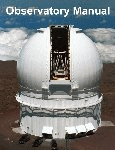 Section 4
- THE TELESCOPE
Section 4
- THE TELESCOPE Section 4
- THE TELESCOPE
Section 4
- THE TELESCOPE
TABLE OF CONTENTS
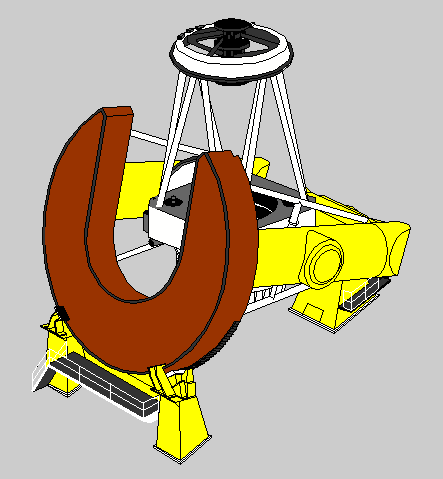
For computations of light throughput, it is interesting to note that a 20th magnitude object gives at 5500 Å flux of 1 photon/second/Å. This number, of course, has to be multiplied by the transmission of the system:
atmosphere + telescope (including central obscuration) + instrument + detector.
The main optical characteristics at the different focii are summarized in the table below:
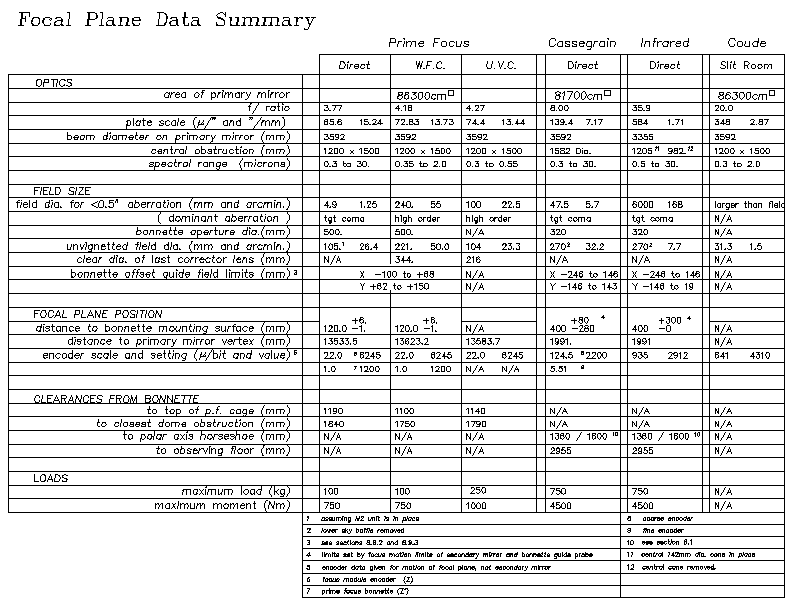
The optical configurations are altered by interchanging three upper ends:
Interchange takes at least 3 hours and cannot be done at night.
- General Characteristics of the f/4 Prime focus
(note: this focus was decommissioned in early 2003 and is being redesigned for use with the WIRCam project)
Mounted above either
the Wide
Field
Corrector or the M2 unit is the Prime Focus Rotator, and then the Prime
Focus
Bonnette - a general purpose guide head. The P.F. Bonnette cannot
be used with the UV Corrector.
Visiting equipment
is usually
mounted
on the PF Bonnette with the focal plane situated 120.0 mm above the
mounting
surface, or on the PF Rotator, with the focal plane situated 450 mm
above
its mounting surface.
Prime Focus optical
configuration
is shown below. Image quality of the primary mirror at the geometrical
focus, according
to optical shop tests, is 0.2 arcsec FWHM.
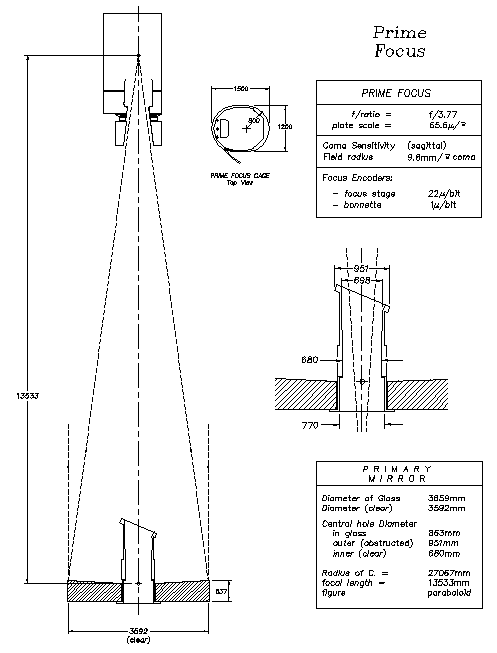
- Prime Focus Cage
Configuration |
Additional payload (kg) |
Naked prime focus |
270 |
Naked PF with guiding head |
162 |
Wide Field Corrector |
274 |
WFC with guiding head |
166 |
UV Corrector |
240 |
MegaPrime, a CFHT project, is a collaboration between CFHT and institutes in France and Canada, with three major industrial contractors. Within a myriad of capabilities, the principal mission of MegaPrime is to offer scientists a field of view of 1 degree by 1 degree, the size of four Full Moons, without compromising the resolution and the image quality.
At the heart of MegaPrime is MegaCam, a unique camera built by the "Département d'Astrophysique, de Physique des Particules, de Physique Nucléaire et de l'Instrumentation Associée" at the French "Commissariat à l'Energie Atomique" (CEA). To cover the 1 square degree field, CFHT ordered 40 CCDs from a company in the United Kingdom, e2v technologies, which specializes in the production of high quality detectors. CEA mounted these CCDs very precisely in a mosaic which central area, made of 4 rows of 9 CCDs, covers a square of 25cm by 25cm, or 1 degree by 1 degree on the sky.
When used for astronomical applications, CCDs have to be operated at very low temperatures to reduce the amount of thermic noise they generate during the long exposures (minutes to tens of minutes) typical of astronomical images. The mosaic is installed in a cryostat where the CCDs can be cooled to -120 degree Celsius. In order to minimize the thermal losses through temperature exchanges with the air, a high quality vacuum is maintained in the cryostat; the mosaic is cooled by a special cryogenics system based on pressure waves in pressurized helium, which extract the heat from inside the cryostat.
CEA also built the camera's shutter, a rotating half-disk able to uniformly open and close the camera for exposure times as short as 1 second; CEA also fashioned a filter jukebox which allows the observation of the sky in different colors, an essential device as the CCDs cannot disclose any color information by themselves.
The last key components built by CEA are the electronics needed to extract the image from the CCDs: each MegaCam image is currently made of 340 megapixels that have to be read quickly and carefully, without degrading the image. The MegaCam electronics designed by CEA can read the image in less than 35 seconds while maintaining a very low readout noise - this is, in fact, the shortest readout time ever achieved on a mosaic operated at CFHT!
As it was not possible to accommodate a 1 square degree field of view with the old cage of the early days (still in use for CFH12K), a new, upper end of the telescope had to be constructed. Designed at CFHT in collaboration with the "Division technique" of the French "Institut National des Sciences de l'Univers", it was built by a Californian company, L&F Industries, now a division of Erie Press Systems. 13 meters above the main mirror of the telescope, this upper end offers a platform ready to host the equipment needed to give to the camera a nice view of the sky.
The parabolic main mirror of the telescope does not produce, alone, a good image of the whole field of view; a wide field corrector (WFC) is installed in front of the camera. With four lenses 50 to 80 cm in diameter, in a structure two meters long for 660 kg, the WFC is an amazing piece of optics designed at the Herzberg Institute for Astrophysics (Victoria, Canada) and built in France by SAGEM/REOSC. The resultant pixel size is slightly less than 0.2 arc-seconds: a good resolution giving a reasonable sampling of the images even with good seeing (images of 0.5" were already observed several times). To complement the corrector, 5 filters were also fabricated by SAGEM. They follow relatively closely the Sloan Digital Sky Survey filter set, but for the blue filter, which makes good use of the superior transparency of the Mauna Kea sky and the UV enhanced WFC glass.
To accommodate the changes in focal length of the telescope with temperature, and the focus position changes induced by the various filters, the camera must be able to move along the optical axis of the telescope. The focus stage assembly (FSA) accommodates this motion, supporting the camera and its shutter on a motorized stage bolted on top of the upper end platform. In order to follow the apparent motion of the sky due to the Earth's rotation, two small cameras fix on stars outside of the field of view, providing automatic guidance of the telescope and measurements of the focal changes.
The guiding cameras ('guiders') are installed underneath the FSA, and like the FSA, were designed and built at HIA. To compensate for telescope oscillations due to windshakes or telescope tracking anomalies, an Image Stabilizing Unit (ISU) made of a tip/tilt plate is attached to the beam on top of the wide field corrector. Designed at "Observatoire de Paris", the ISU is servo-controlled through the guiders' signals.
The integration and overall control of MegaPrime, and all the utilities - helium lines, glycol hoses to eliminate all the heat sources on top of the telescope, electronics box housings, hundreds of yards of cables or optics fibers - and the development of the observing environment specific to MegaPrime, have been CFHT's work.
- The various components of MegaPrime
- Overall weight added to the telescope: 11,000 kg
- Weight to be lifted up and down when the instrument is installed/removed: 5700 kg
- Observing runs: 15 to 18 days periods centered on the New Moon
Upper End
The new prime focus upper end (PFUE) has been designed at CFHT with the help of INSU-Division Technique: a new base ring, a new set of spiders, and a prime focus base which will receive all the other components of MegaPrime. The PFUE has been built on the West Coast of the USA by L&F Ind.
In addition to its basic structure, the PFUE provides a temperature controlled environment for MegaCam and its readout electronics. A temperature controlled enclosure for the electronics of MegaPrime is installed on the telescope "caisson central".
- Total weight of the structure itself: 3000 kg
- Base ring: 2400 kg
- Spiders: 1100 kg
- Prime Focuse Environment base: 500kg
- With all the Megaprime equipment: 5700 kg
- Overall height from the base ring to the top of the cover: 6 m
Wide Field Corrector
The parabolic main mirror of the telescope does not produce, alone, a good image of the whole field of view; a Wide Field Corrector (WFC) is installed in front of the camera. The WFC has been designed at HIA
(Victoria, Canada). The lenses have been fabricated by SAGEM/REOSC, which also built the mechanical structure of the WFC and coated the lenses.
- Total weight: 660 kg
- Overall height: 1.9 m
- Four spherical lenses in BSL7-Y (enhanced UV transparency glass)
- Lens diameter:
- First lens: 81 cm
- All others: between 50 and 56 cm
- Image quality: designed to achieve better than 0.3" diameter at 80% encircled energy from u to z on most of the field.
Image Stabilizing Unit
The Image Stabilizing Unit (ISU) has been designed and built at Observatoire de Paris. It is used to produce small image position correction on the focal plane of MegaCam: a glass plate in the optical beam in front the camera can be tilted and its produces a displacement of the image proportional to the small angle of the tilt.
- Tip-tilt plate: fused silica
- Diameter: 480 mm
- Overall weight (including electronics): 55 kg
- Motion amplitude: +/- 1.2 degrees (or +/- 1 arcsecond on the focal plane)
- Image correction bandwidth: up to 5 Hz
- Internal loop frequency: 50 Hz
Focus Stage/Guiding Focus Sensing
The Focus Stage Assembly (FSA) is supporting the camera and allows its motion along the optical axis in order to accommodate the focus variation due mainly to filter changes and temperature induced telescope dilatation. Two guiders (GFSU) located under the top plate of the FSA give a position and focus information from two guide stars on the North and South edges of the MegaCam field of view.
The FSA and GFSU hardware have been designed and built at HIA, while the the control has been designed and realized at CFHT.
- Focus stage
- Weight of the FSA itself: 260 kg
- Weight supported (camera, shutter and cryogenics): up to 250 kg
- Repeatability of the motion along the optical axis: 0.01 mm
- Motion speed: 1mm/second
- Guiding/focus sensing
- Limiting magnitude: ~15th magnitude
- Guiding field area: 20' x 7' for each guider
MegaCam
At the heart of MegaPrime is MegaCam, a unique camera built by the "Département d'Astrophysique, de Physique des Particules, de Physique Nucléaire et de l'Instrumentation Associée" at the French "Commissariat à l'Energie Atomique" (CEA). In addition to a cryostat housing the mosaic, and its criogenics system to maintain it cold, CEA built the camera shutter, the filter jukebox and the electonics to acquire the image and and send it to a computer through fiber optics cables.
- Overall mass: 350 kg
- Mobile mass (moving with the FSA): 230 kg
- Cryostat
- Cold plate temperature: -130 degrees Celsius
- Readout electronics
- Readout time: 30s
- Readout noise: less than 5 electrons
- Shutter
- Type: Half rotating disk
- Diameter: 1 m
- Minimum exposure time: 1 second
- Filter jukebox
- Number of filters: 8
- Filter change time (in any position of the telescope): 2 mn
CCDs
Charge Coupled Devices (CCDs) are the detector of choice in astronomy for observations in visible light. Appeared in the early eighties, they have since replaced the photographic plates or films used in astronomy for more than a century. The CCDs used for MegaPrime have been built by e2v technologies.
- CCD type: CCD42-90
- Number of CCDs: 40
- Number of CCDs currently used: 36 (a square of 4 rows of 9 CCDs)
- CCD size: 2048 x 4612 pixels
- Pixel size: 13.5 micrometers
- Pixel scale: 0.185 arsecond/pixel
- Image size (whole mosaic): 378 Megapixels
- Image size (current): 340 Megapixels
- Operating temperature: -120 degrees Celsius
The CFHT coudé spectrograph, commonly referred to as Gecko, provides spectroscopists with a spectral resolving power R up to 120,000 from the atmospheric cutoff near 3000Å to 1µm for CCD's with up to 4400 13.5µm pixels. Unlike most echelle spectrographs, Gecko has been optimized for use with a single spectral order (between 5 and 18) from the 316 groove/mm echellette mosaic. Order sorting is achieved with interference filters or by one of three variable grisms. An image slicer is used to optimize the throughput of the instrument. To minimize traffic into and out of the inner coudé room, the entire spectrograph can be operated remotely from the control room.
Since July 2000, CAFE, the CAssegrain Fiber Environment, replaces the red coudé mirror train with optical fibers. CAFE consists of an optical bench mounted to a port on the Cassegrain Bonnette, two fiber optic cables and a Bowen-Wallraven slicer for injecting the beam into the Gecko Spectrograph. A "fiber agitator" (which agitates the optical fiber with an amplitude of 1 mm and a frequency of 30 Hz) has been installed to prevent modal noise and the S/N degradation associated with it. Flat field correction seems to be better than with the coudé mirror train.
An autoguider system is also in use at coudé focues. The 16 meter diameter combined spectrograph/slit room is in the central, vibration isolated portion of the building. These rooms are in thermal equilibrium. Instruments with significant heat dissipation are not permitted in them.
- CAFE Description
- The CAFE is an instrument to replace the old coude mirror train with a fiber optic. The project consists of 3 pieces:
The CAFE was built for CFHT by Jacques Baudrand, Rene Vitry, and Michel Lesserter at the Observatoire de Paris-Meudon.
- An optical bench mounted to a port on the Cassegrain Bonnette which contains a holder for the fiber, feed optics for the fiber, flat field and spectral (ThAr) calibration lamps, feed optics for the calibration lamps, and a mechanism to select between telescope feed and calibration feed. The light from the telescope will be fed into this optical bench using the Cassegrain Bonnette central mirror. The electronics for the optical bench will be controlled from a crate mounted on the Cassegrain environment.
- Two fiber optic cables (one for spare) with microlenses on either end to shape the beam. The fibers will be ~28 m long.
- Optics for injecting the beam into the Gecko Spectrograph. This will be a Bowen-Wallraven slicer to which the fiber cable will be attached. The beam will be injected into the spectrograph at f/20 as is currently the case with the coude train.
CAFE was first delivered to CFHT at the end of September 1999 and a preliminary acceptance test was held at CFHT with Jacques Baudrand and Rene Vitry of OPM during the last two weeks of October. The tests went well with much progress being made on the controller software in the two weeks Jacques and Rene were here. Optically and mechanically, CAFE was shown to be very stable and reliable.
CAFE returned to CFHT in mid-2000 and was used for the first time for science in July 2000. CAFE is now a commissioned instrument at CFHT and is the primary feed for Gecko.
- General Characteristics
This is a classical Cassegrain configuration using a hyperboloidal secondary mirror. The f/ratio is f/8.00 giving a platescale of 139.4m per arcsecond. Field size is limited by the central aperture of the Cassegrain Bonnette to an unvignetted diameter of 32.2 arcminutes (270 mm). The focal plane is nominally located 400 mm behind the Cassegrain Bonnette mounting surface. It can be focussed over a range from approximately 120 mm to 480 mm behind the Bonnette in which Bonnette field acquisition and guiding are available. For a focus at distance p (mm) from the nominal focus, the resulting third order longitudinal spherical aberration is : 7xp microns (p > o if focus down).
Note that since the secondary mirror does not have the correct shape required, it is permanently distorted in its cell through air bag pressure to get the stigmatic focus at the nominal position.
Since it is a classical Cassegrain, the on axis image is stigmatic. However, coma length grows at the rate of 1 arcsecond per 5.7 arcminutes (48 mm) off axis. On-axis optical image quality is currently limited to about 0.3 arcseconds
FWHM by residual alignment and mirror support errors.
The large secondary mirror produces a 1.58 meter diameter central obstruction with the upper Cassegrain baffle in place (or a 19% area loss)
- TV Guiding
- Focussing
- Overview
All structures below the primary mirror cell, including the Cassegrain bonnette, mounted instruments and electronic racks as well as instrumentation panels, are rotated as a single unit and constitute the Cassegrain environment. There is a liberal amount of general purpose standard 19 inch rack space available for instrumentation electronics.
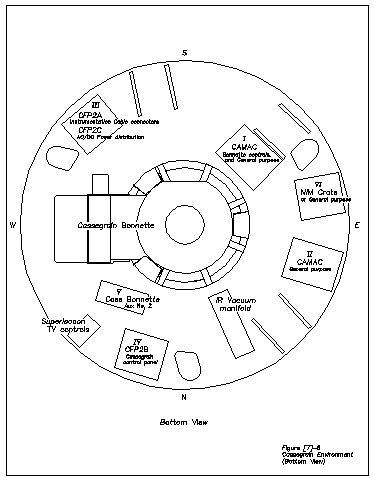
- Access to Cassegrain Focus
The Cassegrain focus has no observers cage. A large manlift is available which permits access except when pointing near the horizon. For such extreme telescope positions smaller, but higher, manlifts, (Wild Cat), are available.
- Mounting of Equipment
Please advise daycrew of any equipment being mounted in an out-of-balance position so that a suitable counter balance can be prepared should Cassegrain environment rotation be desired.
- Rotation
Rotation control of the Cassegrain environment is normally done via a standard handpaddle attached to the main console in the control/observing room. It could also be similarly controlled from the unit. Instructions for same are found adjacent to the handpaddles. An encoder position readout of the Cassegrain environment can be taken either from the TV monitor at Cassegrain environment or from the fourth floor monitor. The rotation encoder resolution is approximately 0.1 degrees.
The normal parking position for the Cassegrain environment is zero° (the long end of the Cassegrain bonnette which contains the acquisition TV pointing due West). Total rotation available is +/- 95 degrees.
- Electric Power
Electrical power for the Cassegrain environment is controlled with the Cassegrain Focus Panel 2C (CFP2C).
The following
D.C. power is
available
at Cass.
+ 5V at 7.2AThe commons for each of these supplies are isolated. They can be tied together if the user desires.
12V at 2.3A each
15V at 2.6A each
24V at 2.4A each
48V at 5A
Distribution of these supplies is at the front panel of the CFP2C. The connectors are arranged in groups according to the
The switch labeled "LEDs" on the CFP2C front panel is provided to give a visual indication of the status of the controllable
The following A.C.
power is
available
at Cass.
220 V.A.C. 50 HZ power is available in standard French sockets
800 watts maximum.
208 V.A.C. 60 HZ 3 phase power is available in standard French sockets
2000 watts maximum.
208 V.A.C. 60 HZ 3 phase power is available in standard American sockets
3000 watts maximum.
110 V.A.C. 60 HZ power is available in several places at Cass.
- Instrumentation Cabling
The general purpose instrumentation cabling available at the Cassegrain focus consists of various sizes of overall shielded twisted pair, individually shielded twisted pair and coax cables. These connectors run between the CFP2A (Cassegrain Focus Panel 2A) at the Cassegrain environment and the CPP2 in the observers room on the fourth floor.
- Cryogen Pumping System
- Overview
Instruments at the F/8 and F/36 Cassegrain focii are mounted on the Cassegrain Bonnette, which provides a TV camera to monitor the field, a retractable field finder and a guiding probe. Maximum capacity and maximum moment with respect to the mounting plate are respectively.
Mounting face C1: 100 kg and 600 NM.Clearances from the back surface of the Cassegrain guiding head are as follows:
Mounting face C2: 300 kg and 1800 NM.
Mounting face C3: 450 kg and 2700 NM.
Mounting face C4: 750 kg and 4500 NM.
(1) to observing floor (declination limits about -30o to +72o) - 3.00 m.
(2) to north pier (for declinations less than -30o) - 1.48 m.
(3) to south pier (for declinations greater than +72o) - 1.61 m.
It is also possible
to use a flat mirror to send the
beam
to the side of the guiding head. Four positions are available at
90o
intervals.
The useful field is 4 arc minute. Maximum capacity on a side
port is 50
kg and maximum moment with respect to the
mounting plate 150 NM.
- Mounting of Equipment
For special applications a side port is also available for mounting small instruments. Contact the Director prior to proposing
- TV Guiding System
- Computer Control
When a guide star is chosen and the tracking rate of the telescope has been controlled by the Observing Assistant, the astronomer can operate in the autoguider mode. It is put in operation by the O.A. and generally performs well. In actual operation 16x16 pixels, each 0.46 x 0.38 arc sec wide, centered on the star are digitized, the centroid is calculated by real time software and the resulting corrections sent to the telescope control system. Careful flexure measurements on the telescope have shown that an accuracy of at least 0.1 arc second per hour is attained at F/8.